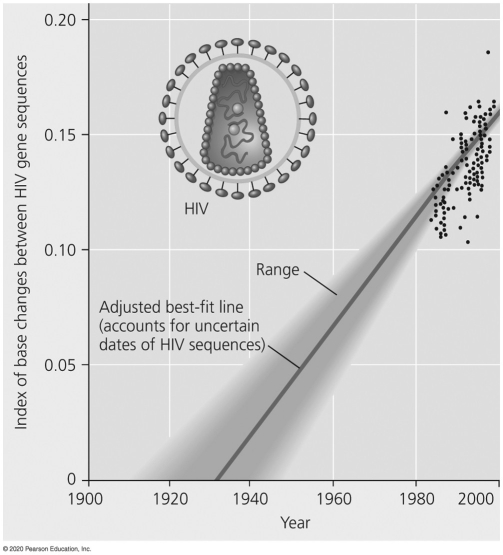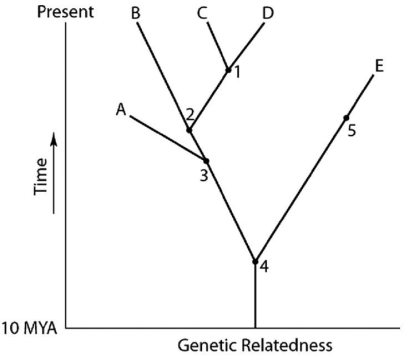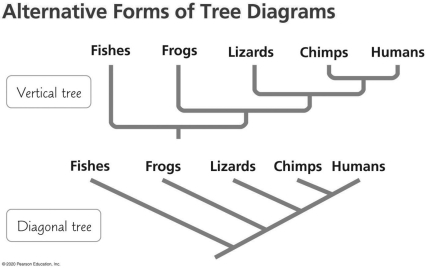A) It is a shared derived character of mammals,even if cynodonts continue to be classified as reptiles.
B) It is a shared derived character of the amniote clade and not of the mammal clade.
C) It is a shared ancestral character of the amniote clade,but only if cynodonts are reclassified as mammals.
D) It is a shared derived character of the mammals,but only if cynodonts are reclassified as mammals.
Correct Answer

verified
Correct Answer
verified
Multiple Choice
One morphological feature of modern cetaceans is a vestigial pelvic girdle.If it is determined that cetacean lineage diverged from the artiodactyls' lineage after the divergence of pigs and other artiodactyla,then what should be true of the vestigial pelvic girdle of cetaceans?
A) It should be considered a shared ancestral character of the cetartiodactyls.
B) It should be considered a shared derived character of the cetartiodactyls.
C) It should be considered a shared ancestral character of the cetaceans.
D) It should be considered a shared derived character of the cetaceans.
Correct Answer

verified
Correct Answer
verified
Multiple Choice
 Figure 20.20
Extrapolating backward in time using the molecular clock indicates that the HIV-1 M strain originated around
Figure 20.20
Extrapolating backward in time using the molecular clock indicates that the HIV-1 M strain originated around
A) 1920.
B) 1930.
C) 1950.
D) 1960.
Correct Answer

verified
Correct Answer
verified
Multiple Choice
Cladograms (a type of phylogenetic tree) constructed from evidence from molecular systematics are based on similarities in
A) morphology.
B) the pattern of embryological development.
C) biochemical pathways.
D) mutations to homologous genes.
Correct Answer

verified
Correct Answer
verified
Multiple Choice
Three living species X,Y,and Z share a common ancestor T,as do extinct species U and V.A grouping that consists of species T,X,Y,and Z (but not U or V) makes up
A) a monophyletic taxon.
B) an ingroup,with species U as the outgroup.
C) a polyphyletic group.
D) a paraphyletic group.
Correct Answer

verified
Correct Answer
verified
Multiple Choice
Analisa and Mateo,two research anthropologists interested in deciphering the relatedness between four extinct primates,were studying the similarities and differences among a number of measurements of the complex structures of the jaw fragments they collected,as well as making many other morphological contrasts between other fossilized bones from dozens of collected specimens.In the lab,they noticed the lengths of the bones of the leg,particularly the femur,tibia,and fibula,were very different in all the specimens,whereas the jaw structures were nearly identical among the specimens.What should they tentatively conclude based on this evidence?
A) The four primates likely share a close common ancestor or could potentially be the same species based upon the jaw measurements.
B) The hominids with the most closely matching leg bone measurements are likely more closely related than the others,due to the importance of locomotion as an evolutionary adaptation.
C) The femur measurements are not important.
D) Because the measurements of the leg bones vary widely,it is probable that the four species are from different genera.
Correct Answer

verified
Correct Answer
verified
Multiple Choice
The term homoplasy is most applicable to which of the following features?
A) the five-digit condition of human hands and bat wings
B) the β hemoglobin genes of mice and humans
C) the fur that covers Australian moles and North American moles
D) the bones of bat forelimbs and the bones of bird forelimbs
Correct Answer

verified
Correct Answer
verified
Multiple Choice
Which of these would,if it (they) had acted upon a gene,prevent this gene from acting as a reliable molecular clock?
A) neutral mutations
B) genetic drift
C) mutations within introns
D) natural selection
E) most substitution mutations involving a codon's third position (of exons)
Correct Answer

verified
Correct Answer
verified
Multiple Choice
If you were using cladistics to build a phylogenetic tree of cats,which of the following would be the best outgroup?
A) wolf
B) domestic cat
C) frog
D) leopard
Correct Answer

verified
Correct Answer
verified
Multiple Choice
What evidence allowed biologists to conclude that classification of the tree of life required a three-domain system?
A) The validity of three domains is supported by a recent study that sequenced proteins.
B) Most of the currently known prokaryotes belong to three domains.
C) The Archaea domain consists of diverse prokaryotes that inhabit the same habitats.
D) The phylogenetic tree of the three domains of life is based on sequence data for rRNA and other genes.
Correct Answer

verified
Correct Answer
verified
Multiple Choice
 Figure 20.1
-Assuming the phylogenetic tree shown in Figure 20.1 is an accurate depiction of relatedness,then which of the following should be correct?
1) The entire tree is based on maximum parsimony.
2) If all species depicted here make up a taxon,this taxon is monophyletic.
3) The last common ancestor of species B and C occurred more recently than the last common ancestor of species D and E.
4) Species C is the direct ancestor of both species B and species D.
5) The species present at position 3 is ancestral to C,D,and E.
Figure 20.1
-Assuming the phylogenetic tree shown in Figure 20.1 is an accurate depiction of relatedness,then which of the following should be correct?
1) The entire tree is based on maximum parsimony.
2) If all species depicted here make up a taxon,this taxon is monophyletic.
3) The last common ancestor of species B and C occurred more recently than the last common ancestor of species D and E.
4) Species C is the direct ancestor of both species B and species D.
5) The species present at position 3 is ancestral to C,D,and E.
A) 1 and 3
B) 3 and 4
C) 2,3,and 4
D) 1,2,and 3
Correct Answer

verified
Correct Answer
verified
Multiple Choice
 Figure 20.1
-Using the phylogenetic tree shown in Figure 20.1,which extinct species should be the best candidate to serve as the outgroup for the clade whose common ancestor occurs at position 2?
Figure 20.1
-Using the phylogenetic tree shown in Figure 20.1,which extinct species should be the best candidate to serve as the outgroup for the clade whose common ancestor occurs at position 2?
A) A
B) B
C) C
D) D
E) E
Correct Answer

verified
Correct Answer
verified
Multiple Choice
Linnaeus was a "fixist" who believed that species remained fixed in the form in which they had been created.Linnaeus would have been uncomfortable with
A) classifying organisms using the morphospecies concept.
B) the scientific discipline known as taxonomy.
C) phylogenies.
D) nested,ever-more inclusive categories of organisms.
Correct Answer

verified
Correct Answer
verified
Multiple Choice
Placing whales and hippos in the same clade means that
A) these organisms are phenotypically more similar to each other than to any others shown on the trees in the figure.
B) their morphological similarities are probably homoplasies.
C) they had a common ancestor.
D) all three of the responses are correct.
Correct Answer

verified
Correct Answer
verified
Multiple Choice
If it turns out that the whale lineage diverged from the lineage leading to hippos after the divergence of the lineage leading to the pigs and other artiodactyls,and if the whales continue to be classified in the order Cetacea,then what becomes true of the taxon Cetartiodactyla?
A) It should be considered as one monophyletic superorder.
B) It should be considered a superorder that consists of two monophyletic orders.
C) It should be established as a paraphyletic order.
D) It should be thrown out or modified by taxonomists if classification is to reflect evolutionary history.
Correct Answer

verified
Correct Answer
verified
Multiple Choice
Which of the following is true of all horizontally oriented phylogenetic trees,in which time advances to the right?
A) Each branch point represents a point in absolute time.
B) Organisms represented at the base of such trees are descendants of those represented at higher levels.
C) The fewer branch points that occur between two taxa,the more divergent their DNA sequences should be.
D) The common ancestor represented by the rightmost branch point existed more recently in time than the common ancestors represented at branch points located to the left.
Correct Answer

verified
Correct Answer
verified
Multiple Choice
According to the principle of maximum parsimony,
A) phylogenies based in DNA require the most base changes between taxa.
B) the preferred tree is the one that minimizes the amount of evolutionary change.
C) in the case of trees based on morphology,a parsimonious tree requires the most changes.
D) a large number of trees should be examined.
Correct Answer

verified
Correct Answer
verified
Multiple Choice
What is true about this phylogenetic tree? 
A) Fish are equally related to frogs,lizards,chimps and humans.
B) Fish share a common ancestor with frogs but not with lizards,chimps,or humans.
C) Fish are more closely related to grogs than any other groups shown.
D) Chimps and humans have been evolving for the same amount of time.
Correct Answer

verified
Correct Answer
verified
Multiple Choice
Which of the following are problematic when the goal is to construct phylogenies that accurately reflect evolutionary history?
A) polyphyletic taxa
B) paraphyletic taxa
C) monophyletic taxa
D) polyphyletic and paraphyletic taxa
Correct Answer

verified
Correct Answer
verified
Multiple Choice
A polytomy on a phylogenetic tree represents
A) sister taxa.
B) a lineage that diverges from all other lineages in its group.
C) its most recent common ancestor.
D) insufficient data to determine lineage relationship.
Correct Answer

verified
Correct Answer
verified
Showing 21 - 40 of 72
Related Exams